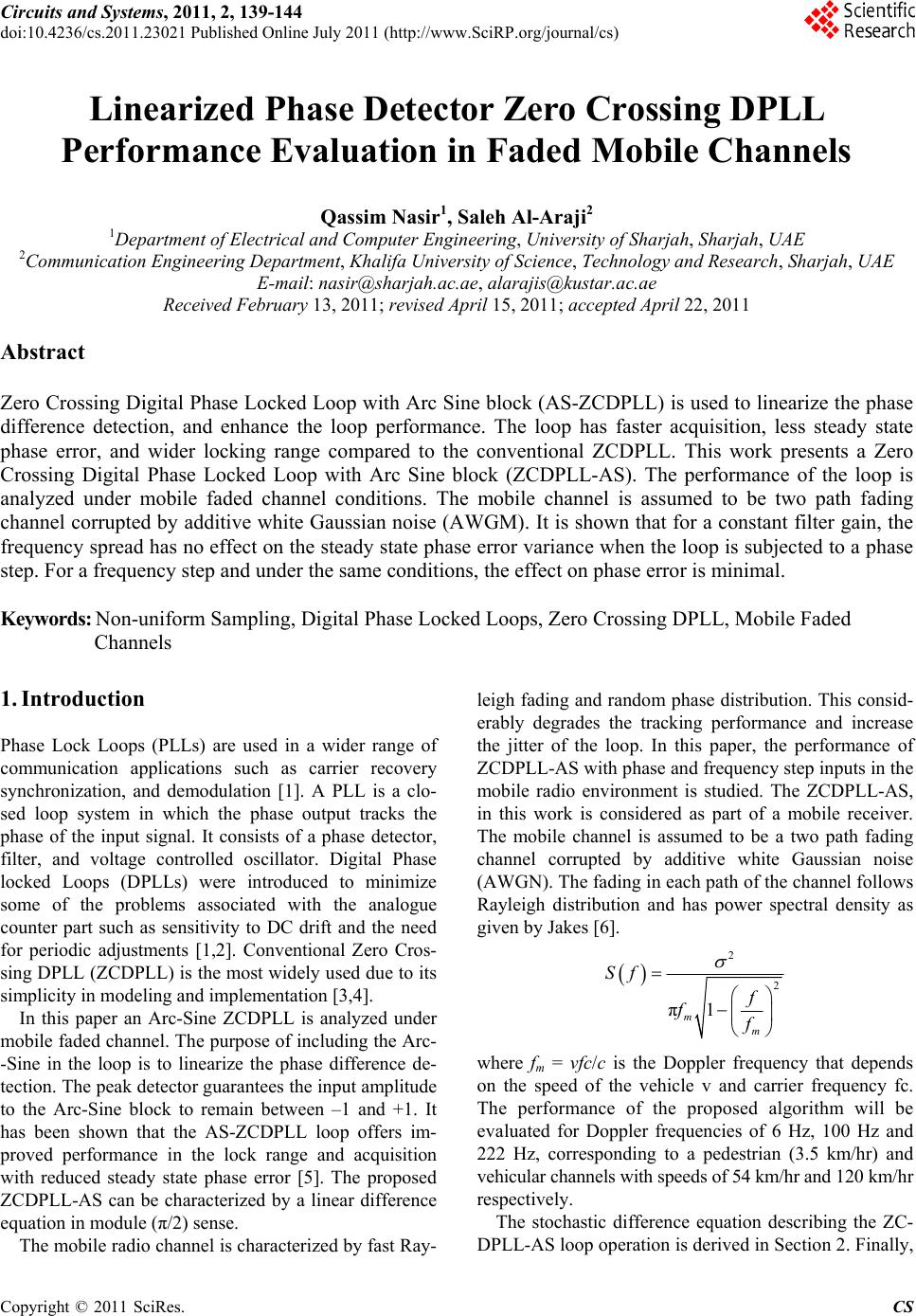
Circuits and Systems, 2011, 2, 139-144
doi:10.4236/cs.2011.23021 Published Online July 2011 (http://www.SciRP.org/journal/cs)
Copyright © 2011 SciRes. CS
Linearized Phase Detector Zero Crossing DPLL
Performance Evaluation in Faded Mobile Channels
Qassim Nasir1, Saleh Al-Araji2
1Department of Electrical and Computer Engineering, University of Sharjah, Sharjah, UAE
2Communication Engineering Department, Khalifa University of Science, Technology and Research, Sharjah, UAE
E-mail: nasir@sharjah.ac.ae, alarajis@kustar.ac.ae
Received February 13, 2011; revised April 15, 2011; accepted April 22, 2011
Abstract
Zero Crossing Digital Phase Locked Loop with Arc Sine block (AS-ZCDPLL) is used to linearize the phase
difference detection, and enhance the loop performance. The loop has faster acquisition, less steady state
phase error, and wider locking range compared to the conventional ZCDPLL. This work presents a Zero
Crossing Digital Phase Locked Loop with Arc Sine block (ZCDPLL-AS). The performance of the loop is
analyzed under mobile faded channel conditions. The mobile channel is assumed to be two path fading
channel corrupted by additive white Gaussian noise (AWGM). It is shown that for a constant filter gain, the
frequency spread has no effect on the steady state phase error variance when the loop is subjected to a phase
step. For a frequency step and under the same conditions, the effect on phase error is minimal.
Keywords: Non-uniform Sampling, Digital Phase Locked Loops, Zero Crossing DPLL, Mobile Faded
Channels
1. Introduction
Phase Lock Loops (PLLs) are used in a wider range of
communication applications such as carrier recovery
synchronization, and demodulation [1]. A PLL is a clo-
sed loop system in which the phase output tracks the
phase of the input signal. It consists of a phase detector,
filter, and voltage controlled oscillator. Digital Phase
locked Loops (DPLLs) were introduced to minimize
some of the problems associated with the analogue
counter part such as sensitivity to DC drift and the need
for periodic adjustments [1,2]. Conventional Zero Cros-
sing DPLL (ZCDPLL) is the most widely used due to its
simplicity in modeling and implementation [3,4].
In this paper an Arc-Sine ZCDPLL is analyzed under
mobile faded channel. The purpose of including the Arc-
-Sine in the loop is to linearize the phase difference de-
tection. The peak detector guarantees the input amplitude
to the Arc-Sine block to remain between –1 and +1. It
has been shown that the AS-ZCDPLL loop offers im-
proved performance in the lock range and acquisition
with reduced steady state phase error [5]. The proposed
ZCDPLL-AS can be characterized by a linear difference
equation in module (π/2) sense.
The mobile radio channel is characterized by fast Ray-
leigh fading and random phase distribution. This consid-
erably degrades the tracking performance and increase
the jitter of the loop. In this paper, the performance of
ZCDPLL-AS with phase and frequency step inputs in the
mobile radio environment is studied. The ZCDPLL-AS,
in this work is considered as part of a mobile receiver.
The mobile channel is assumed to be a two path fading
channel corrupted by additive white Gaussian noise
(AWGN). The fading in each path of the channel follows
Rayleigh distribution and has power spectral density as
given by Jakes [6].
2
2
π1
m
m
Sf
f
ff
where fm = vfc/c is the Doppler frequency that depends
on the speed of the vehicle v and carrier frequency fc.
The performance of the proposed algorithm will be
evaluated for Doppler frequencies of 6 Hz, 100 Hz and
222 Hz, corresponding to a pedestrian (3.5 km/hr) and
vehicular channels with speeds of 54 km/hr and 120 km/hr
respectively.
The stochastic difference equation describing the ZC-
DPLL-AS loop operation is derived in Section 2. Finally,